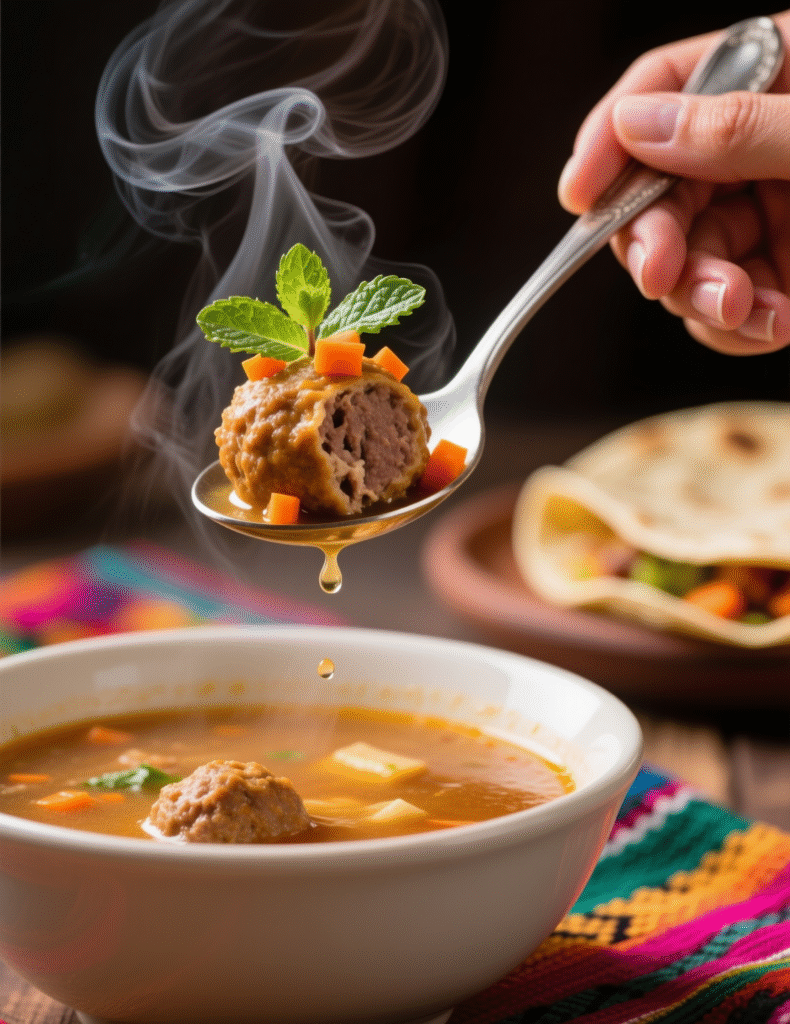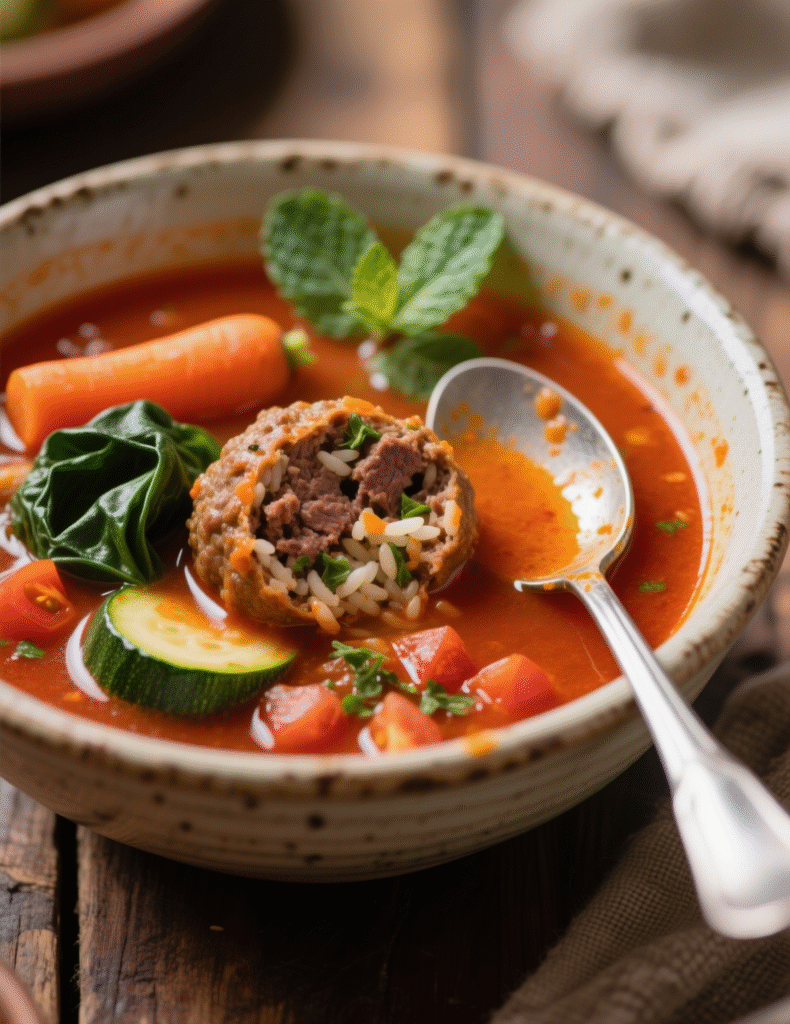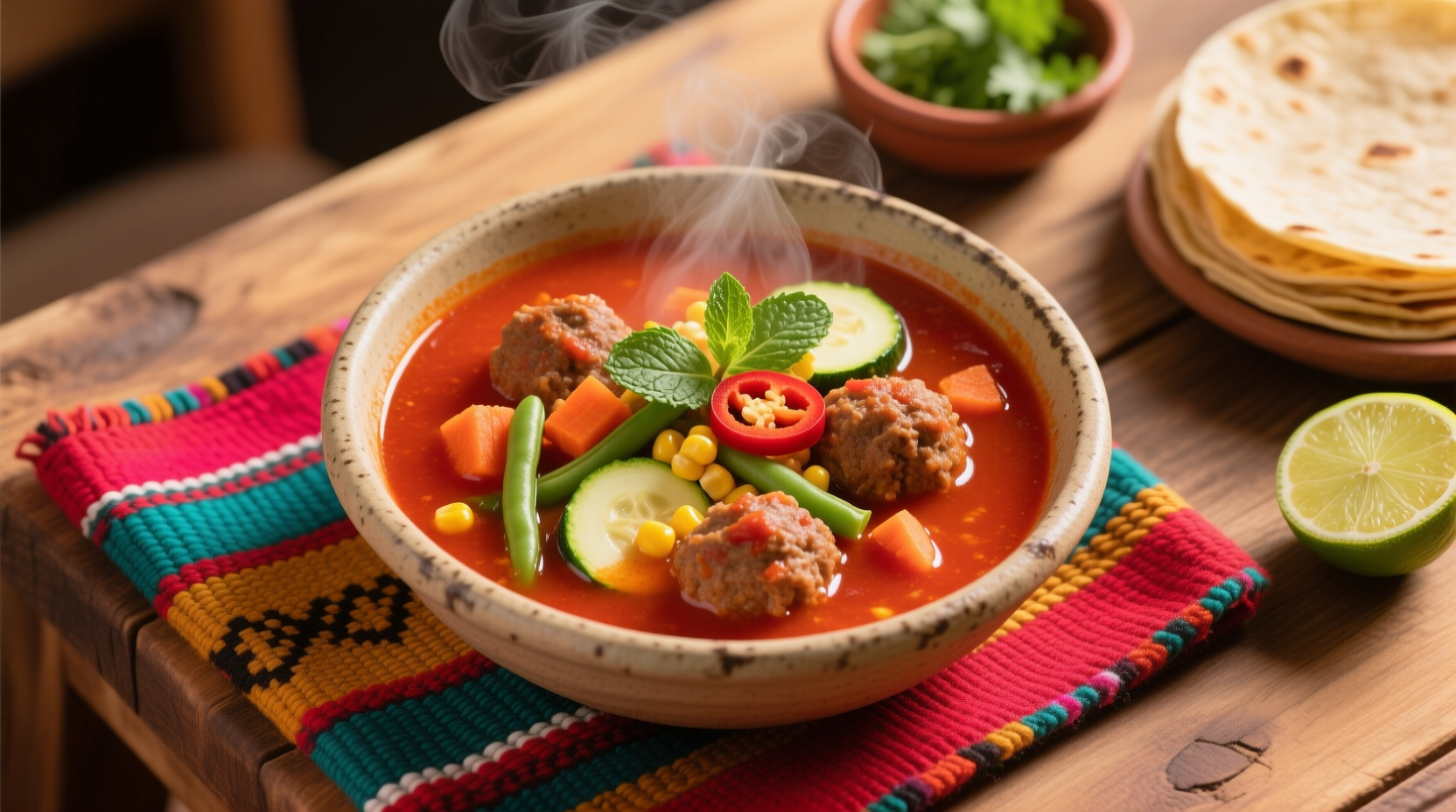It’s not just soup. It’s albondigas. A bowlful of warmth that travels generations, kitchens, and hearts across Mexico. But what makes this rustic dish so compelling? It’s the kind of comfort food that doesn’t just feed the body—it cradles the soul. Especially when those meatballs carry whispers of fresh mint.
In this article, we’re not just walking through a recipe. We’re diving deep into the culinary roots of traditional Mexican albondigas soup, exploring the reasons why mint actually matters, and understanding how vegetables are more than just filler—they’re character players in the pot. Whether you’re a chef plating for five-star experiences or a serious home cook who doesn’t blink at a 6-hour simmer, this is your terrain.
Let’s get the pot rolling.
What Exactly Is Albondigas Soup?
The word albondigas comes from the Arabic al-bunduq, meaning “little round thing.” Spain adopted it during the Moorish occupation, and Mexico made it soul food.
In simplest terms? It’s a meatball soup. But nothing about it is simple when done right.
In traditional Mexican kitchens, albondigas are often made from ground beef or pork (sometimes both), mixed with rice, fresh herbs, and spices. Then comes the broth—usually tomato-based, deeply savory, lightly spicy, often kissed with the green crunch of veggies like carrots, zucchini, and sometimes potatoes. The broth isn’t just soup stock. It’s poetry on a slow boil.
And then—there’s mint.
The Role of Fresh Mint: Not a Garnish, a Gamechanger
Let’s get one thing clear. Mint isn’t thrown in just because somebody’s abuela ran out of cilantro.
No, fresh mint in albondigas is a signature. It’s a flavor curveball that hits the meatballs from the inside. And it works like a charm.
You’ll bite into the soft, juicy albondiga, and suddenly—bam—there’s this cool, almost floral brightness that lifts the richness. It cuts through the fat. Balances the umami. In professional kitchens, we’d call it contrast. At home, it’s called mmm.
Interestingly, Mexican mint (Yerba Buena) isn’t always the same as spearmint or peppermint. It’s more delicate, with a hint of citrus and spice. But in a pinch, fresh spearmint works beautifully.

Let’s Talk Texture: Why the Rice Inside Matters
Rice isn’t a side dish here—it’s inside the meatballs.
That changes everything.
Uncooked rice mixed into the ground meat absorbs broth as it cooks. This gives the albondigas a soft, almost pillowy texture. If you use cooked rice instead, you risk dense meatballs that break apart or feel dry.
Some cooks swear by soaking the rice in broth first. Others go rogue and use a combo of rice and breadcrumbs for better binding. But if you’re a purist—stick to raw white rice, lightly salted.
And yes, brown rice? It takes longer. And it’ll change the mouthfeel. You’ve been warned.
Anatomy of the Perfect Albondiga
Let’s break it down like we’re doing kitchen prep:
- Protein: Ground beef with at least 15% fat. Pork adds flavor depth, but too much and your balls fall apart—literally.
- Binder: Uncooked long-grain rice. Not sticky rice. Not risotto rice. You want structure, not sludge.
- Herbs: Mint, cilantro, and sometimes oregano. Some old-school cooks even add a whisper of cumin or garlic powder.
- Egg: One per pound of meat. Don’t overdo it or you get rubbery spheres.
- Salt: Don’t be shy. A bland albondiga is an offense to the ancestors.
Roll them gently. Overworking the mix makes tough meatballs. You want to shape, not sculpt.
The Broth: It’s Not a Sauce, It’s a Canvas
The broth is where everything happens. Think of it like a stage for your actors. Without it, the show’s off.
You’ll typically start with a base of blended tomatoes, garlic, and onion. This forms the foundation. Chicken stock or beef broth adds depth. Then you build.
Some chefs roast the tomatoes first—adds smokiness. Others use canned fire-roasted ones for consistency.
Spices? Go light. Maybe a pinch of cumin, maybe a bay leaf. You want the meatballs and veggies to shine, not drown in chili.
Let it simmer until the veggies are tender but not mushy. Overcooked squash is a crime.
A Note on Consistency
This isn’t minestrone. It’s not chunky stew. It’s supposed to be a soup. So keep the broth-to-solid ratio balanced. Add a splash of water or broth if things start looking too crowded.
Vegetables: More Than Just a Color Boost
Carrots, zucchini, green beans, sometimes corn. These aren’t afterthoughts.
Each veggie plays a role.
- Carrots bring sweetness and chew.
- Zucchini offers soft texture that complements the meatballs.
- Green beans add snap, especially if added late.
- Chayote, a lesser-used but traditional veggie, adds a mild, crisp bite.
Timing matters. Toss everything in at the start, and you’ll get mush. Layer them in stages, depending on their cooking time.
Carrots go in early. Zucchini goes in halfway. Green beans go in during the last 10 minutes.
Keep your knife work clean. Uneven sizes cook unevenly. You don’t want a raw chunk next to a dissolving sliver.

Regional Variations: From Oaxaca to Michoacán
Albondigas soup isn’t one-size-fits-all.
In Oaxaca, cooks might add chipotle for a smoky kick. In Michoacán, you’ll find versions that use serrano peppers and even a bit of masa harina to tighten the broth.
In Northern Mexico, beef dominates. In the south, you might find turkey or even chicken-based albondigas.
The broth’s thickness also varies—some lean toward stew, others toward consommé. And in coastal areas? Shrimp albondigas exist. And they slap, hard.
So if someone tells you there’s one right way—nope. There’s just the way that tastes like home.
Nutritional Perspective: It’s a Hidden Powerhouse
Let’s look at some numbers.
A typical serving (about 2 cups) of albondigas soup made traditionally contains:
- 250–300 calories
- 15–20g protein
- 8–12g fat
- 3–5g fiber
- Rich in vitamins A, C, potassium, and iron
That’s pretty nutrient-dense for a comfort dish. Especially if you control the sodium and go lean on meat fat.
Use bone broth? Boom—collagen boost.
Add kale or spinach toward the end? More micronutrients without flavor interference.
Even the mint offers digestive benefits. It’s not just for taste—it literally helps your stomach break down that hearty meat.
Common Mistakes That Ruin the Soup
Let’s get real about what not to do:
- Overmixing the meat. It’ll make the meatballs dense. No one wants bouncy balls.
- Adding all veggies at once. You’ll get soup sludge.
- Using dried mint. Don’t do it. It tastes like toothpaste and regret.
- Skipping the rice. It ain’t albondigas without rice. That’s just meatball soup. Sad.
- Boiling instead of simmering. Fast heat breaks the meatballs. Low and slow, always.
Emerging Twists and Trends
In modern kitchens, albondigas soup is having a moment. Chefs are experimenting, and frankly—it’s exciting.
- Lamb albondigas with harissa for fusion flair.
- Vegetarian versions using lentils, mushrooms, or tofu.
- Sous-vide meatballs for precise texture.
- Infused broths using dried guajillo or pasilla chiles.
And get this: In L.A., some taquerias serve albondigas soup with a soft-boiled egg on top. Rich, runny yolk spilling into the broth? Decadent.
Even the mint is getting a remix. Some are using epazote or lemon verbena to switch up the herbaceous note.
Expert Tips from the Line
Here’s what chefs behind the scenes swear by:
- Always taste the broth before adding meatballs. Once they’re in, there’s no going back.
- Freeze extra albondigas raw, not cooked. They hold shape and flavor better when simmered fresh.
- A splash of lime at the end wakes the whole bowl up. Add it right before serving.
- Reheat gently. High heat toughens the meat and wrecks the veggies.
Final Stir: Why This Dish Matters
Albondigas soup is more than a recipe—it’s a culinary story. A spoonful of history wrapped in herbs, rice, and love. In professional kitchens, it’s a masterclass in balance. At home, it’s a warm hug in a bowl.
You don’t just make albondigas soup. You craft it. You taste, tweak, feel, and wait.
And if you do it with fresh mint, good rice, and patience?
You’ve nailed it.
You’ve honored the tradition.
And somewhere, an abuela nods in approval.
Now—go roll those meatballs.
FAQs
What is traditional Mexican albondigas soup made of?
It’s a tomato-based broth with meatballs made from ground meat, rice, fresh mint, and mixed vegetables.
Why is mint used in albondigas soup?
Mint adds a fresh, cool contrast that brightens the flavor of the meatballs.
Can I use cooked rice in the meatballs?
It’s better to use uncooked rice so it absorbs broth and keeps the meatballs tender.
What kind of meat works best for albondigas?
Ground beef with a little fat, sometimes mixed with pork, gives the best flavor and texture.
Can I make albondigas soup ahead of time?
Yes, but store the meatballs and broth separately for best results when reheating.
What vegetables go into albondigas soup?
Common ones include carrots, zucchini, potatoes, and green beans.
Is there a vegetarian version of albondigas soup?
Yes, you can use lentils, mushrooms, or tofu instead of meat for the albondigas.
How do I keep the meatballs from falling apart?
Don’t overmix, use enough rice and egg, and simmer gently—not boil.
Can I freeze albondigas soup?
Freeze the raw meatballs separately and add them fresh when making the soup.
Is dried mint okay to use?
Nope—fresh mint is essential for the proper flavor in authentic albondigas.

Mariana is a passionate home cook who creates delicious, easy-to-follow recipes for busy people. From energizing breakfasts to satisfying dinners and indulgent desserts, her dishes are designed to fuel both your body and hustle.
When she’s not in the kitchen, she’s exploring new flavors and dreaming up her next recipe to share with the Foodie Hustle community.

